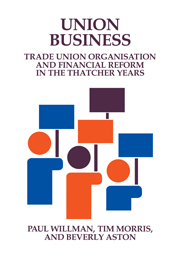Book contents
- Frontmatter
- Contents
- Acknowledgements
- 1 Introduction: unions in the 1980s
- 2 The financial status of British trade unions 1950–1989
- 3 Financial differences between unions
- 4 The role of financial matters in union organisation
- 5 The politics of union finaces
- 6 Union size, growth, and financial performance
- 7 Strike activity and union finances
- 8 The National Union of Mineworkers: strikes and financial disaster
- 9 The GMB: merger and financial reform
- 10 The Amalgamated Engineering Union: back from the brink
- 11 The Banking, Insurance and Finance Union: competitive unionism and financial survival
- 12 The Electrical, Electronic, Telecommunications and Plumbing Trade Union: accountability and financial control
- 13 Conclusions: union business and business unionism
- Appendix 1 Research methods
- Appendix 2 Regression results
- Appendix 3 Questions for finance officers
- Appendix 4 Questions for General Secretaries
- Appendix 5 Questionnaire: trade union finances
- Appendix 6 The number of trade unions
- Notes
- References
- Subject index
- Index of trade unions
- Author index
10 - The Amalgamated Engineering Union: back from the brink
Published online by Cambridge University Press: 11 March 2010
- Frontmatter
- Contents
- Acknowledgements
- 1 Introduction: unions in the 1980s
- 2 The financial status of British trade unions 1950–1989
- 3 Financial differences between unions
- 4 The role of financial matters in union organisation
- 5 The politics of union finaces
- 6 Union size, growth, and financial performance
- 7 Strike activity and union finances
- 8 The National Union of Mineworkers: strikes and financial disaster
- 9 The GMB: merger and financial reform
- 10 The Amalgamated Engineering Union: back from the brink
- 11 The Banking, Insurance and Finance Union: competitive unionism and financial survival
- 12 The Electrical, Electronic, Telecommunications and Plumbing Trade Union: accountability and financial control
- 13 Conclusions: union business and business unionism
- Appendix 1 Research methods
- Appendix 2 Regression results
- Appendix 3 Questions for finance officers
- Appendix 4 Questions for General Secretaries
- Appendix 5 Questionnaire: trade union finances
- Appendix 6 The number of trade unions
- Notes
- References
- Subject index
- Index of trade unions
- Author index
Summary
Historical background
The Amalgamated Engineering Union (AEU) can trace its history back, through several changes of name but few of structure, to the foundation of the Amalgamated Society of Engineers (ASE) in 1851. Its features, much praised by the Webbs (1907) as a major development in the history of trade unionism, included craft exclusiveness, high contributions and benefits, and a high level of financial centralisation combined with the devolution of a high level of autonomy over collective bargaining matters to district committees.
Many of these original features have disappeared. The craft exclusiveness progressively disappeared with the dilution of skills in the engineering industry and the spread of union membership into other areas. By 1985, only 30% of the union's membership were in skilled categories, although the majority of officials still had craft origins. The union's subscription rates, 70p per week, were in that year among the lowest of the major unions; their subscription yield was easily the lowest.
However, there is a great deal of continuity in structure and government. The full-time Executive Council (EC), which runs the union, was established in 1892. The National Committee (NC), the ruling body of the union, was established in 1920. District committees relying on the activities of lay members have been the key to the union's operation for over a century.
This may be because of the relatively low level of merger activity evident in the union's history. Four episodes are relevant. The first, in 1851, established the ASE. The second, in 1920, combined the ASE with a number of smaller craft societies to form the AEU.
- Type
- Chapter
- Information
- Union BusinessTrade Union Organisation and Financial Reform in the Thatcher Years, pp. 154 - 169Publisher: Cambridge University PressPrint publication year: 1993



